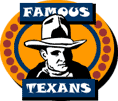
 Howard Hughes
Howard Hughes
|

 Howard Hughes
Howard Hughes
"I am determined to elect a president of our choosing this year and one who will be deeply indebted, and who will recognize his indebtedness. Since I am willing to go beyond all limitations on this, I think we should be able to select a candidate and a party who knows the facts of political life....If we select Nixon, then he, I know for sure knows the facts of life." -- from handwritten memos by Howard Hughes, early in the 1968 presidential campaign
Best known for: aviator, movie producer, billionaire, hypochondriac.
Born: Howard Robard Hughes, Jr., December 24, 1905, in Houston.
Family: Mother: Allene (Gano) Hughes (died March 29, 1922); Father: Howard Robard Hughes, Sr., founder of Hughes Tool Company (died January 14, 1924); Uncle: father's brother Rupert, a writer for Samuel Goldwyn's movie studios; Wives: Houston socialite Ella Rice (married June 1, 1925, divorced in 1929); Actress Jean Peters (married 1957, divorced 1970); Hughes often dated Hollywood actresses in the 1930s, especially Katherine Hepburn.
Education: Hughes attended private school in Boston, where he was better at golf than classwork. He was attending Thacher School in California when his mother died. In California, Hughes spent time with his uncle, Rupert, who inspired his later interest in filmmaking. Hughes never graduated from high school. Nonetheless, his father arranged for him to sit in on classes at Cal Tech by donating money to the school. Afterward, Howard returned to Houston and enrolled at Rice Institute (now Rice University). Howard, Sr. died suddenly a few weeks after his son turned eighteen. Young Howard inherited much of the family estate and dropped out of Rice.
Profession: Family business: Uncle Rupert supervised Howard's part of the estate and interests in the Hughes Tool Company until he was twenty-one. Family quarrels led Howard to have company lawyers buy out his relatives. A Houston judge and friend of his late father's granted Howard legal adulthood on December 26, 1924, allowing him to take over the tool company.
Career: Movies: Following the summer of 1924, Howard and Ella moved to Hollywood to pursue Howard's interest in making movies. When his first attempt failed, he hired Noah Dietrich to head the movie subsidiary of his tool company, and Lewis Mileston as director. The new team won an academy award for Two Arabian Nights (1928). Their next film, Hell's Angels (1930), written and directed by Hughes and starring Jean Harlow, was the most expensive movie of its time at a cost of $3.8 million. This movie, about World War I aviators, lost $1.5 million at the box office but allowed Hughes to indulge his interest in flying. While shooting Hell's Angels, Hughes earned his pilot's license. Two later Hughes films tested the limits of public morality. Scarface (1932) was censored until Hughes sued to allow its release, and The Outlaw (1941) became controversial for its sexually explicit advertising and content, both featuring a sensational décolletage worn by a busty Jane Russell. Inspired by the excitement over The Outlaw, Hughes later took a break from airplane fuselage design to create the half-cup bra, modelled of course by his Hollywood discovery, Jane Russell. It was in the '30s that Hughes built the Texas Theater, the movie house in the Oak Cliff section of Dallas in which Lee Harvey Oswald was arrested in 1963. The closeness of both men to the CIA makes it all but certain that the Texas Theater would have become a clandestine meeting place for spies. Such use of movie theaters had long been a staple of espionage tradecraft, and other Hughes properties were put to similar use. Hughes owned the RKO movie studio from 1948 to 1955.
Aviation: In 1932, Hughes formed the Hughes Aircraft Company division of Hughes Tool. The company has pioneered many innovations in aerospace technology. But its origin was an attempt to finance the expensive conversion of a military plane into a racing plane. The next year, he achieved a false status by lobbying the Commerce Department to lower his pilot's license number from 4223 to 80. Charles Lindbergh's number was 69. The only real job Hughes ever had also came in 1933. He signed on as a co-pilot for American Airways. He applied under the name Charles W. Howard. The ruse was quickly discovered, however, and Hughes resigned. After entering and winning the 1934 All-America Air Meet in Miami, Hughes built and personally test-piloted the world's most advanced plane, the H-1. On September 13, 1935, he set a new speed record, taking the plane to 352 mph. Over the next two years, he set two new records with transcontinental flights. Between July 10 and 14, 1938, Hughes piloted a special Lockheed 14 with a crew of four on a flight around the world. He cut Lindbergh's New York to Paris record in half, and finished the trip in three days, nineteen hours and seventeen minutes. Houston's airport was renamed in his honor. As World War II approached, Hughes turned his full attention to building military aircraft. But his regard for secrecy and disregard for military protocol and standardized materials kept him from getting contracts. Henry J. Kaiser, the famous shipbuilder, helped Hughes get a contract to build three "flying boats" for $18 million in three months. Those terms proved impossible for Hughes. In the end, he produced only one of the planes after the war ended. It was flown only once on November 2, 1947, by Hughes himself. The public ridiculed him by calling the plane "The Spruce Goose." Another wartime contract for reconnaissance planes went similarly unfulfilled, and caused the deaths of two people when Hughes crashed during a test flight at Lake Mead. In 1947, the Senate investigated Hughes failure to meet his wartime contracts. In the 1950s and beyond, Hughes manufactured spy satellites.
Military-Industrial Complex: Throughout the 1950s, as the power of three entities grew -- the Hughes empire, organized crime, and the new Central Intelligence Agency -- it became all but impossible to distinguish between them. By the end of the decade, Hughes' chief of staff, Robert Maheu, had orchestrated the CIA's dirtiest secret -- plots to assassinate Cuban leader Fidel Castro with the help of two heads of organized crime. Vice President Richard Nixon was the White House action officer in the clandestine attempts to oust Castro. Zapata Off-Shore, the oil company owned by future CIA director and U.S. president George Bush after he split it off from Zapata Oil partner Hugh Liedtke in 1954, had a drilling rig on the Cay Sal Bank in 1958. These islands had been leased to Nixon supporter and CIA contractor Howard Hughes the previous year and were later used as a base for CIA raids on Cuba. Nixon lost the 1960 presidential election to John F. Kennedy largely because of a scandal over a never repaid $205,000 "loan" Nixon's brother received from Hughes. As attorney general, Robert Kennedy secretly investigated the Hughes-Nixon dealings.
After Bobby Kennedy's assassination in 1968, Maheu and Hughes hired long-time Kennedy advisor Larry O'Brien along with other political insiders to protect their interests in Washington. In 1953, Hughes had founded the Hughes Medical Institute in Delaware as his sole act of philanthropy. By turning over all of the stock of Hughes Aircraft Company to the institute, he made his billion-dollar-a-year weapons factory a tax-exempt charity. By 1969, that scam was about to be shut down by a Senate bill, which followed an investigation by fellow Texan Wright Patman, the powerful chairman of the House Banking Committee. But O'Brien lobbied his allies and got a loophole creating an exemption for "medical research organizations" like the Hughes Medical Institute.
President Nixon's downfall began when he ordered burglars to break into Larry O'Brien's office in 1972. At the time, O'Brien was both a Hughes employee and chairman of the Democratic National Committee, headquartered in the Watergate Hotel. The Watergate burglars happened to have been heavily involved in the covert anti-Castro operations (which Nixon oversaw as vice president). They were also deeply involved in the conspiracies which grew out of those operations; conspiracies which prevented any major political future for the Kennedy family, and led directly to Nixon's resurrection from political obscurity. The purpose of the break-in was never revealed because the Watergate scandal's investigations were sidetracked, likely on purpose, into a focus on multiple other high crimes by Nixon. Whatever the purpose of the break-in, Hughes was right in the middle of the major forces linking the conspiracies that resulted in the murders and character assassinations of the Kennedy brothers, and the Watergate scandal that toppled the Nixon administration.
During all of these political intrigues, arguments between Hughes and his employees continued to threaten military contracts and resulted in his firing his long-time associate Noah Dietrich in 1957. As a stockholder in Trans World Airways, Hughes lobbied for the airline's purchase of sixty-three jets in 1956. He sold his TWA stock in 1966 for $546 million when the company faced numerous lawsuits. That same year, Hughes moved to Las Vegas and began doing business there. Las Vegas organized crime interests were actively transferring casino ownership to frontmen with less tainted reputations.
Hughes took over Air West in 1970. (He was later indicted in the Air West takeover, but the case was dismissed.) Hughes was increasingly reclusive and decreasingly in control of his business dealings. Not even Nixon could contact him directly. Maheu's power was also declining. The CIA assassination plots had begun to leak to the press, requiring the government to distance itself from Maheu. Not only did he know too much, it was one of his associates, attorney Ed Morgan, who had leaked the story to columnist Jack Anderson. It was now Chester Davis, Raymond Holliday, and Bill Gay, the Hughes Tool Company executives who ran Hughes Nevada properties, who were contacted by the CIA when they wanted to build a CIA ship, the Glomar Explorer, to recover a sunken Soviet submarine.
In 1972, Hughes sold Hughes Tool Company's stock and renamed his company Summa Corporation, ending any remaining role in his business. His health deteriorated and his entourage of aids carted him to Panama, Canada, London and Acapulco. On June 5, 1974, a break-in occurred at Hughes' Romaine Street headquarters in Los Angeles. The theft of secret documents sent shockwaves through the U.S. intelligence community.
Death: Hughes died April 5, 1976, en route by private jet to a hospital in Houston. His drastically changed appearance and the fact that he had been seen by so few people for so long forced the Treasury Department to use fingerprints to identify his body. He left an estate estimated at $2 billion. Four hundred prospective heirs tried to inherit it but it eventually went to twenty-two cousins on both sides of his family. Texas, Nevada and California claimed inheritance-tax in disputes reviewed by the Supreme Court three times. Hughes Aircraft ended up in the hands of Hughes Medical Institute, which sold it to General Motors in 1985 for $5 billion. Four hotels and six casinos in Las Vegas and Reno remained with Summa Corporation.
Bibliography: Walter F.
Pilcher, "Hughes, Howard Robard, Jr." The Handbook of Texas Online.
<http://www.tshaonline.org/handbook/online/index.html>; Chantal S.A. Web site,
History: 1950, < http://www.chantal.fr/anglais/milneucencinqu.htm>;
Michael Drosnin, Citizen Hughes (New York: Bantam Books, 1985) pp. 6, 89, 89n., 272,
298-300, 309-311, 407-409, 430-431; 463, 539; "Zapata Petroleum Corp.," Fortune
magazine, Apr. 1958, p. 248; Warren Hinckle with William Turner, The Fish is Red, (NY:
Harper & Row, 1981), pp. 67-69, 279-80; republished as Deadly Secrets,
Thunder's Mouth Press, 1992; Richard Bartholomew, “Possible Discovery of an
Automobile Used in the JFK Conspiracy” (self-published manuscript, 1993, p. 63; Fair
Play Magazine, Issue 17, July-August 1997).